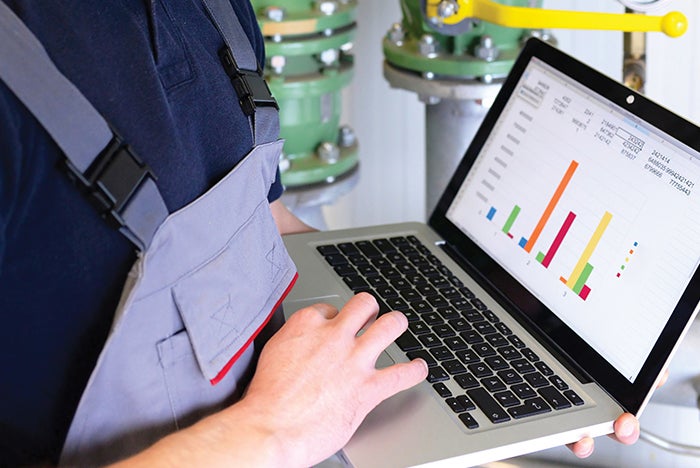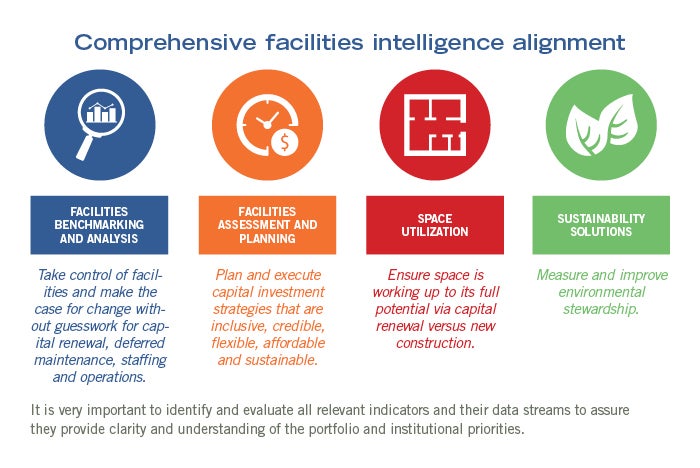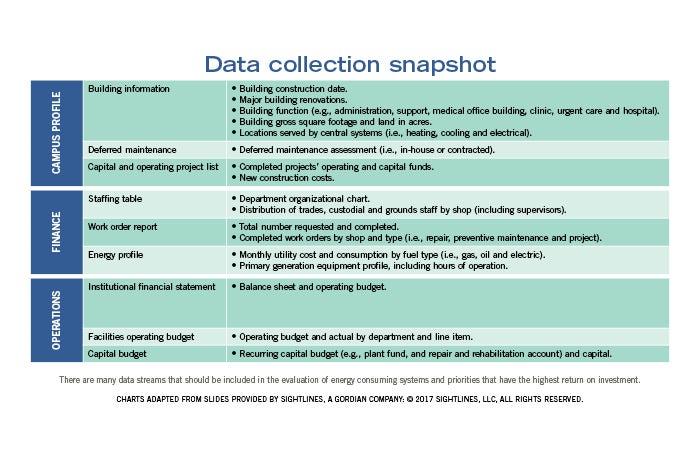Data-driven facility planning

All infrastructure systems should be included in the assessment to assure proper allocation of resources.
Image from Getty Images
Over the past 10 years, a great deal of dialogue and a number of new technologies have emerged to help health facilities managers tell their facilities’ story to senior leadership.
Most of the focus has been on energy-consuming equipment and energy-efficiency initiatives, some as part of partnerships that provide project funding. Although not the primary goal, investing in energy efficiency also reduces the institution’s deferred maintenance backlog.
However, it does not address all aging systems and space within the built environment. There is much more to facilities analytics than just energy efficiency. To achieve total project alignment, the institution will need a much broader approach to reverse ballooning capital renewal and deferred maintenance backlogs.
The most effective solutions include data analysis of the complete facilities portfolio to assure alignment with the strategic missions of the institution and prioritized patient care.
Complete analysis
Evaluating the dynamics of health facilities operations is both an art and a science. Approximately 16 to 18 percent of the total cost to own and operate a health facility is related to the first cost of construction. The other 82 to 84 percent comes from owning and operating it over its useful life.
Resources
Past behavior has been to spend what was necessary during construction to bring the latest facility and technology to the patient. However, funding operations has been less significant than needed and a major contributor to the ballooning backlog of capital renewal and deferred maintenance within the field.
One of the missing elements is good data analysis collected from important leading and lagging indicators of quality and effectiveness for improved decision making. It is important to evaluate the complete in situ condition of the health facility’s function, which includes a comprehensive evaluation of facility intelligence to improve alignment with the missions.
All infrastructure systems should be included in the assessment to assure proper allocation of resources to mitigate the various operational risks. However, many overlooked systems routinely create the biggest challenges when they have been left in a run-to-fail mode.
For instance, older facilities have aging sewer lines that have exceeded their useful life and fail frequently, spewing waste. Electrical distribution equipment that has exceeded its useful life can fail unexpectedly and result in relocation of patients and services. Likewise, roofs are never a problem when it’s not raining. But if they are beyond their useful lives and a big storm comes through, they become the highest priority to resolve.
Systems such as these can be thought of as critical mission support, and proportional funding allocations should be dedicated to assuring their resiliency. When sewer lines, electrical distribution gear and roofs work, they are not on leadership’s list of required improvements. However, when they fail, they become critical and the highest priority of the institution to resolve, immediately.
Unfortunately, many of these systems cannot be evaluated by testing and require management from life cycle analysis, manufacturer’s recommendations and engineering best practices. Predictive strategies are very effective as well and, combined with effective data analytics, can become leading indicators of future risks and downtime.
Additional measures
There are industry standards for facilities data collection that should be evaluated and are well known by most administrators, particularly chief financial officers. They include various metrics for cost rates that can be evaluated to determine mean performance compared to the field.
These indices define performance to budget and alone are not leading indicators without considering the quality of the outcomes and achievement of operations as compared to the institution’s strategic plan. As with all service enterprises, the voice of the customer should be included in the analysis to assure their perspective is prioritized when telling the story.
There are many additional and more subtle measures that should be evaluated to better understand the uniqueness and effectiveness of the team.
Best practice involves introducing a few additional tools to assure a robust understanding of the opportunity. For example, adding net asset value (NAV) as a leading indicator in the assessment puts the life cycle of the facility in the forefront of discussion. NAV provides a much better understanding of what the future looks like as a projection of remaining percent of the asset’s useful life based on current budget and operational behaviors.
Another key indicator might be admissions and discharges by category to determine if the number of beds and ancillary services are aligned with patient demand and treated disease. An evaluation of “left and right handedness” of the bed location in the patient room along with travel distance and obstacles to maneuver to reach the restroom are excellent indicators for recommendations to reduce slips and falls.
Coupled with reviews of shifts, overtime allocations and other data streams can be identified and evaluated as potential contributors to care delivery errors while at the bedside. A slip and fall can be devastating for many critically ill patients as well as employees of the institution. Understanding these concerns and how they contribute to the institution’s bottom line is an important element of risk and facilities management.
Subtler indices
The subtler indices can be thought of as the parenthesis around the mean benchmark that define higher and lower outcomes or, more specifically, the reason for an excess of patient transfers and backlog in the emergency department, post-operative care and the intensive care unit (ICU).


Charts adapted from slides provided by Sightlines, a Gordian Company: © 2017 Sightlines, LLC, all rights reserved.
A best practice used by leading institutions aligns their facilities budget with their corporate strategy and could recommend capital renewal projects to right-size the treatment space to the actual demand. This usually occurs throughout the field for large capital projects but many times to the detriment of the operating budget. It is very important to identify and evaluate all relevant indicators and their data streams to assure they provide clarity and understanding of the portfolio and institutional priorities.
For example, an institution might forgo funding capital renewal and deferred maintenance (CRDM) during a building campaign to direct all available funds to support the campaign. More importantly, as new space is brought on campus, the total gross square foot denominator grows. The resulting percent of facilities that are in the critical age of their life cycle might appear to be less when actually expanding to include more facilities and increasing pressure on the CRDM backlog in the future.
Managing energy-consuming systems is important and offers unique opportunities to provide funding for other strategic initiatives from the savings achieved from reduced consumption. As the infrastructure becomes more sophisticated, it is important to assure staffing does as well. Evaluating the competencies of the team to assure training programs are aligned with skills and skill deficits is paramount to obtain the return on investment (ROI) in energy efficiency projects.
Expecting technicians to climb to the higher level of performance on their own is not tactically enough to support energy investment strategy. Design teams and general contractors are not required by standard contract language to assure institutional competency to own and operate high-efficiency equipment unless specifically addressed in their agreements.
There are many data streams that should be included in the evaluation of energy consuming systems and priorities that have the highest ROI. Best practice recommendations should include reinvestment strategies from energy savings to reduce the backlog of CRDM. This is an area where significant investment has occurred in technology to assist the operations and maintenance team to assure the savings.
Including human resources in the evaluation can assure the facilities team that effective training programs can be sourced for both in-house and business-partner delivery. No energy-efficient equipment will provide the expected ROI without the daily vigilance of trained and competent personnel.
Comparative analysis is an excellent way to understand how more successful institutions staff and manage these complex investments. It is important to understand that the first opportunity to achieve the promised ROI occurs after taking substantial completion of the project and the equipment is operating optimally.
Success is predicated on management of the system and is not guaranteed without measurement and verification. These are excellent opportunities for professional facilities teams but require skills and tenacity to achieve the goal.
It is important to present the total story to the executive team to improve their understanding of how their funding strategy is working overtime. Most importantly, by using NAV projections for useful life, the executive team can learn how their funding behaviors will impact the backlogs in the future.
The value is tenfold for facilities leadership as they gain a more profound understanding of how their team is engaged in the responsibilities to improve departmental outcomes.
Capital priorities
During the past decade, most health care institutions have doubled in size while pent-up demand for services increased. Because of the complexity of their operations and philanthropic support, it was more advantageous to build new facilities than prioritize capital renewal.
These new facilities have given institutions more competitive care delivery sites and have supported the growth necessary to succeed financially. However, there are only a limited number of institutions that need more space today. An emerging priority is more effective use of existing space along with assurance the design of renewed space is efficient and improves throughput.
As facilities age, they also drift away from their design intent. Technologies and treatments change over time, and the efficiency and appropriateness of the built environment becomes less effective and, in some cases, a detriment to delivering care.
Density is a factor as more heavily utilized space ages more rapidly than less utilized. Density is also a contributor to safety-related issues that can reduce care effectiveness and increase staff fatigue and burnout. To many, an aged and leaking roof is an eyesore, but it can be a devastating event for immunocompromised patients, clinicians and researchers.
There are many elements of the facilities portfolio that represent opportunities for improvement when data is properly collected and analyzed.
Many older health facility designs were less collaborative and the result of working with a limited number of professionals without a functional understanding of the challenges of delivering care in the space. Some of these designs were predicated on heaviest day rather than most effective throughput. The result is that the space might not be efficient for its use.
Additionally, cultural challenges for capital approval may also have resulted in a hoarder mentality to block space for reassignment for more productive use. By utilizing careful and artful evaluation of the data analyzed from the various value streams, along with an evaluation of the space, recommendations can be more relatable to effective and efficient operations.
Patient transfers, long waits in the post-anesthesia care unit and emergency department along with overcrowding in the ICU are all a result of improper understanding and analysis of the data available. At the same time, these institutions might only have a 60 percent occupancy rate and a real opportunity for effective capital renewal. Most hospitals have some form of digital admission data that can be evaluated for a more effective understanding of historical data for proper space allocations.
Improved decisions
Health facility professionals can facilitate this discussion when they have the data analytics for improved decision making. The goal is to facilitate total project alignment by infusing decision making with data analysis to improve description of the facilities portfolio.
Factoring in the elements within the space can incent discussions and be used to address deferred maintenance concerns resulting in more efficient capital renewal activities and total project alignment.
Mark A. Kenneday, CHFM, FASHE, CHC, is director of business development at Sightlines, a Gordian Company, in Guilford, Conn. He
can be contacted via email at m.kenneday@sightlines.com.




